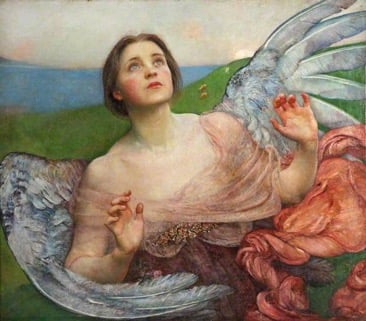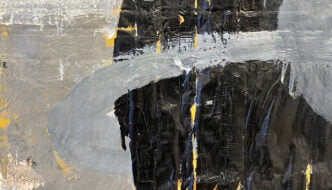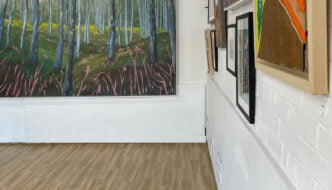“Strength is removed from the shackles of masculinity”: Annie Swynnerton @ Mcr Art Gallery
March 6, 2018
By Emil Margrain and Sidonie Mepsted

The Sense of Sight (1895). Courtesy of Manchester Art Gallery
The work of English painter Annie Swynnerton (1844-1933) has returned to Manchester Art Gallery’s walls for the artist’s first retrospective in nearly a decade. For contemporary audiences, the paintings are, at a glance, museum-y, often aspiring for photo-realism and favouring subtlety. It can be challenging when presented with the visual language of the museum not to immediately assume the hand of the bourgeois male artist, sat before his subject – potentially a Weinstein-esque type – definitely the benefactor of an unequal world. Swynnerton’s work is different.
This difference glistens with varying clarity throughout the works featured in Painting Light and Hope, but finds perhaps its best manifestation in the modestly sized ‘Illusions’ (1902), which depicts a young girl in armour. The iconography of the painting, when separated into its individual constituents, is nothing new; its symbols of strength, confidence, youth and beauty are ones we see repeated again and again. The arrangement, however, is unexpected; a young girl appears strong, glowing in the light and standing comfortably in well fitted armour. Strength is removed from the shackles of masculinity, and youth is emboldened, not fragile, ushering in hope for a younger generation.
This symbolism is deeply rooted in the artist’s politics. Swynnerton, a founding member of the Manchester Society of Women Painters, disapproved of the conventions of her time and was deeply aligned with the suffrage movement. Her painting, ’Joan of Arc’ (c. early 1900) is believed to have been the catalyst for the Suffragettes’ use of the icon throughout their branding, with similar images found in the society’s advertisements and badges.
Another motif in Swynnerton’s work is her frank, un-idealised depictions of women, best exemplified within the exhibition by the portrait of Dame Millicent Garrett Fawcett (1847–1929). The wrinkles around Fawcett’s eyes are deep and textured, literally scratched into the layers of paint. Swynnerton refreshingly presents the Dame as more than an object for the male gaze, creating a conflict with the surplus of male-painted nudes littered throughout the museums and galleries of the world. Fawcett is depicted as a real person, wearing the robes of the University of St Andrews, the institution that awarded her an Honorary Doctorate in Law for services to education in 1899: a figure of admiration on her own terms.
With 2018 marking the 100-year anniversary of The Representation of People Act, which allowed women over thirty who owned five pounds’ worth of property (about two hundred and seventy-five pounds today) or had a husband who did, to vote in general elections, now is a timely moment for the reintroduction of Annie Swynnerton’s work into Manchester Art Gallery. Swynnerton unfortunately belongs to the list of female artists recognised in their time and forgotten in their absence. Swynnerton’s practice proves relevant today in remembering the achievements of the suffrage movement and in bringing to light the scale of the remaining struggle for gender equality. Dame Laura Knight, the first woman elected to full membership of the Royal Academy, said about Swynnerton, “We women who have the good fortune to be born later than Swynnerton profit by her accomplishments. Any woman reaching the heights in the fine arts had been almost unknown until Mrs Swynnerton came and broke down the barriers of prejudice”. Swynnerton’s story is of a struggle, but a struggle essential in paving the way for female artists succeeding her.
Filed under: Art & Photography
Tagged with: Annie Swynnerton, female painters, hope, Joan of Arc, light, Manchester Art Gallery, painting, retrospective, suffragettes, Swynnerton



Comments